AFC Funds Performance Summary
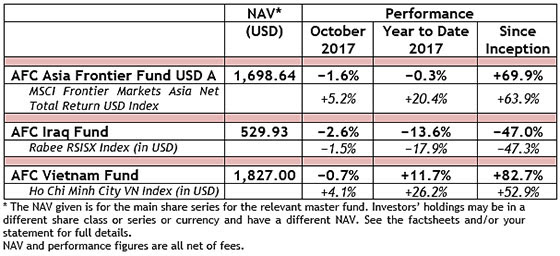
Major equity markets rallied this past month and frontier markets generally fared well as the MSCI Frontier Markets Net Total Return USD Index gained +1.2% this month and is now up +26.4% YTD, while the MSCI Frontier Markets Asia Net Total Return USD added +5.2% this month and is up +20.4% for the year. However, the rally in this index last month was primarily due to one stock from Vietnam which we discuss further below.
Larger markets in our universe such as Pakistan continued to face challenges while in Vietnam the rally over the past month was primarily due to a few large cap names. Benchmarks for both the AFC Asia Frontier Fund and AFC Vietnam Fund performed well primarily due to a price rally (+87% last month) in one particular Vietnamese construction company (FLC Faros), which has a high weighting in both benchmarks. Our research shows that there is no solid foundation for this sudden increase in valuation, and so we shy away from this particular stock. We discuss more on this company later in this newsletter. The AFC Asia Frontier Fund is now up +69.9% since inception, which corresponds to a healthy annualized return of +10.0% p.a. since inception, reflecting the strategy’s ability to generate consistent long-term returns.
The AFC Iraq Fund returned −2.6% in October, underperforming its benchmark, the Rabee USD index, which lost −1.5% and its performance year-to-date is −13.6% compared with the benchmark which is down −17.9% for the year.
The AFC Vietnam Fund lost −0.7% in October, underperforming the VN-Index in USD terms which gained +4.1%. The fund is now up +11.7% YTD and +82.7% since inception, which corresponds to an attractive annualized return of +16.9% p.a.
Launch of the AFC Asia Frontier “Parallel Fund” in Luxembourg
In order to provide better and easier access for our European investors, Asia Frontier Capital has launched a “Parallel Fund” of the AFC Asia Frontier Fund in a Luxembourg in a SICAV fund structure. Subscriptions for the AFC Asia Frontier Fund (LUX) are now open, and the inception date will be 1st December 2017.
The Luxembourg-based fund will invest up to 84% in the existing Cayman Islands-based AFC Asia Frontier Fund (Non-US) and the balance will be invested directly in stocks that the Cayman Islands fund is also holding. We expect that the performance of the Luxembourg based fund will be very similar to the existing Cayman Islands-based fund.
If you have any questions about our funds or would like any additional information, please be in touch with our team at info@asiafrontiercapital.com.
Launch of a Japanese Yen share class for the AFC Vietnam Fund
As a result of the strong demand from our Japanese investors, we are introducing an additional share class for the AFC Vietnam Fund in Japanese Yen. Subscription to this share class is now open.
AFC Vietnam Fund redemption notice period reduced
The directors of the fund have decided to reduce the notice period for redemptions for all share classes of the AFC Vietnam Fund from 60 days to 30 days as of October 2017. This will make the AFC Vietnam Fund certainly more attractive for new investors while the existing shareholders will benefit too. The broad diversification of fund investors and investments and growing fund size (around USD 42 million) led to this decision.
Iraq Banking and Investment Summit in Baghdad
AFC Iraq Fund’s CIO Ahmed Tabaqchali will be presenting at the Iraq Banking and Investment Summit to be held at the Royal Tulip Al Resheed Hotel in Baghdad on the 2nd and 3rd of December. The conference is being held for the first time in Baghdad and will provide a platform for the discussions on the exciting opportunities and growth prospects within Iraq. For more information visit www.iraqbanking.net.
If you have any questions about our funds or would like any additional information, please be in touch with our team at info@asiafrontiercapital.com.
Upcoming AFC Travel
Thomas Hugger, Ruchir Desai and Peter de Vries are based in Hong Kong, while Andreas Vogelsanger is based in Bangkok and Ahmed Tabaqchali in London. If you have an interest in meeting with our team at their homeports or during their travels, please contact Peter de Vries at pdv@asiafrontiercapital.com.
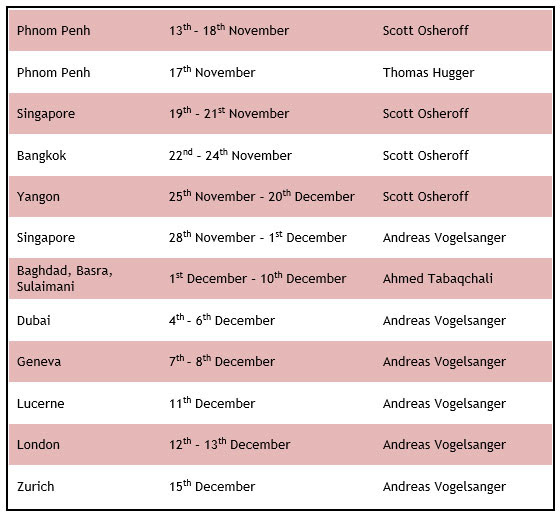
AFC Asia Frontier Fund – Manager Comment October 2017

AFC Asia Frontier Fund (AAFF) USD A-shares lost −1.6% in October 2017. The fund underperformed the MSCI Frontier Markets Asia Net Total Return USD Index (+5.2%), the MSCI Frontier Markets Net Total Return USD Index (+1.2%), and the MSCI World Net Total Return USD Index, which was up +1.9%. The performance of the AFC Asia Frontier Fund A-shares since inception on 31st March 2012 now stands at +69.9% versus the MSCI Frontier Markets Asia Net Total Return USD Index, which is up +63.9%, and the MSCI Frontier Markets Net Total Return USD Index (+54.0%) during the same time period. The fund’s annualized performance since inception is +10.0% p.a., while its YTD performance stands at −0.3%. The broad diversification of the fund’s portfolio has resulted in lower risk with an annualised volatility of 8.90%, a Sharpe ratio of 1.09 and a correlation of the fund versus the MSCI World Net Total Return USD Index of 0.34, all based on monthly observations since inception.
It was a volatile month for the fund, with performance being hit in the last week of October due to a 6% drop in Pakistan’s KSE-100 Index in the last seven trading days of the month. Political noise continues to impact market sentiment and as we get closer to elections (scheduled for July/August 2018), politics will probably continue to impact market sentiment. However, there appears to be some amount of clarity on the political front as the former Prime Minister’s younger brother, Shehbaz Sharif, was chosen by the Pakistan Muslim League as their Prime Ministerial candidate for the upcoming elections. Quarterly results have also not inspired the market as index-heavy banks and cement companies have not declared very positive numbers, but this has been expected over the past few months. Though worries over price competition in the cement sector remain, domestic volumes continue to grow at double digits which indicates that economic activity has not been impacted so far by the political uncertainty. The same applies for auto companies which have declared good quarterly numbers on the back of double-digit volume growth for most companies in the sector in the most recent quarter. Further, industrial production, at 8.5% YoY in August 2017, continued to show broad based growth similar to July 2017. Despite the political uncertainties, economic activities continue to show growth and the CPEC (China Pakistan Economic Corridor) projects continue as the CPEC has backing from all quarters. Though worries over the current account deficit and currency remain, the correction in the market over the past few months has opened up valuations across sectors with the KSE-100 Index trading at a trailing 12 months P/E of 8.1x, a valuation almost similar to prior to the 2013 general elections.
In Bangladesh, most of the fund’s holdings have shown good quarterly results and we continue to remain positive on the consumer story of the country due to disposable incomes rising from a low base backed by a large and young population. If political stability persists going into the elections in 2019, then we can expect more consistent growth from corporates as most sectors from financial services to consumer discretionary are significantly underpenetrated.
Vietnam’s robust economic growth continued, with industrial production growing by 17% YoY in October mainly due to a 22% increase in the manufacturing sector. Foreign direct investment (FDI) continues to remain strong, with disbursed FDI growing by 12% so far this year to USD 14 billion, while commitments have grown by 37% to USD 28 billion. Given the positive economic outlook, we continue to like cyclical names in the real estate, infrastructure, and construction spaces. However, this month’s performance of the Ho Chi Minh VN Index was skewed due to one name, FLC Faros, a construction company which was up 87% during the month and has a weight of 4.5% in the VN Index. This was also the reason why our benchmark increased by more than 5% as this company has a weight of 6% in the benchmark MSCI Frontier Asia Index. We don’t own this name and don’t intend to going forward given a lack of information on this company.
Mongolia was once again the best performing market for the fund as the recovery story continues. On 4th October, Parliament elected U. Khurelsukh as Prime Minister, followed by the appointment of a new cabinet on 18th October. During his short tenure as Prime Minister, U. Khurelsukh has met the IMF to discuss reinstatement of the Extended Fund Facility and on 30thOctober the IMF announced they had reached a staff level agreement. Regarding the country’s finances, on 26th October the government planned to issue a USD 650mln 5-year bond with a coupon of 6.1%, however due to the issuance being oversubscribed the size was increased to USD 800mln and the coupon lowered to 5.625%. This influx of capital will allow Mongolia to rollover its existing debts and clean up its balance sheet.
The best performing indexes in the AAFF universe in October were Mongolia (+10.5%), Vietnam (+4.1%), and Cambodia (+4.1%). The poorest performing markets were Pakistan (−6.6%) and Iraq (−1.5%). The top-performing portfolio stocks this month were: a junior mining company from Mongolia (+36.4%), a cashmere producer from Mongolia (+31.6%), a Pakistani leasing company (+20.5%), a Mongolian industrial company (+19.6%) and a Mongolian oil producer (+17.8%).
In October, we added to existing positions in Laos, Mongolia, Pakistan, and Vietnam. We exited a Mongolian food company and Vietnamese noodle producer and purchased a new Vietnamese food company. Additionally, we partially sold two companies in Vietnam, a consumer conglomerate and a consumer beverage company and also partially sold one construction material company in Mongolia.
As of 31st October 2017, the portfolio was invested in 116 companies, 1 fund and held 4.7% in cash. The two biggest stock positions were a pharmaceutical company in Bangladesh (7.9%) and a pump manufacturer from Vietnam (3.1%). The countries with the largest asset allocation include Vietnam (27.2%), Pakistan (19.6%), and Bangladesh (16.5%). The sectors with the largest allocations of assets are consumer goods (29.7%) and industrials (14.9%). The estimated weighted average trailing portfolio P/E ratio (only companies with profit) was 15.71x, the estimated weighted average P/B ratio was 2.61x, and the estimated portfolio dividend yield was 4.14%.
Factsheet AFC Asia Frontier Fund – October 2017
Factsheet AFC Asia Frontier Fund (non-US) – October 2017
AFC Asia Frontier Fund Presentation (English)
AFC Asia Frontier Fund Presentation (Chinese-Traditional)
AFC Asia Frontier Fund Presentation (Chinese-Simplified)
AFC Iraq Fund – Manager Comment October 2017
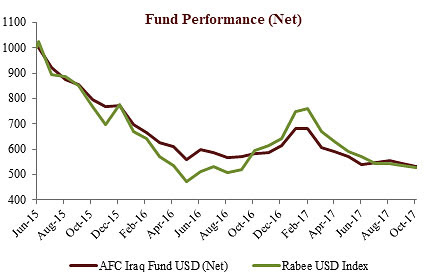
AFC Iraq Fund Class D shares returned −2.6% in October as average daily turnover continued to hover near 3 years lows. The fund under-performed its benchmark, the RSISUSD index, which lost −1.5%. The fund is now down −13.6% YTD, which is an outperformance compared with the RSISUSD index which lost −17.9% in the same time period.
October was mostly a replay of the dog days of the summer as far as the market was concerned. However, two main developments are worth noting: the changed dynamics of oil prices with significant implications for local liquidity, and emerging details of the Saudi led refinancing of the reconstruction of liberated territories.
The market weakened in the last 10 days of the month. However, this weakness was a function of continued low volumes due to the progress of the Arba’een pilgrimage, as reported last month, and not the events in Kirkuk. Average daily turnover was 7% above the multi-year lows of a holiday shortened September but at only 70% of the YTD average daily turnover, which itself is very low to start with. Amid the absence of buying interest most stocks drifted lower, with the market −1.5% for the month, while the portfolio lagged by −1.1% as the holdings that did well through the summer drifted more with almost zero buyers.
The most interesting development in the oil market is the changed supply-demand dynamics from the over-supply of the last three years to balance as the backwardation chart (below) demonstrates. It charts the price difference between the WTI 1st & 7th future months, indicating tightening in the spot market as a function of increased demand relative to supply.
The chart shows how Increased supply following the fight for market share in late 2014 resulted in a huge price gap, followed by weak demand due to a Chinese led global slow-down in the summer of 2015 and culminating in fears of a world awash in oil in early 2016. OPEC’s supply cut in late 2016 was clearly in the direction of least resistance as the market was already moving towards a rebalance. Stronger demand expectations vs constrained OPEC supply with more realistic views of shale supply growth will probably be the fundamental reasoning for firmer prices. The changed dynamics suggest the near-term prices are likely to be in range of USD 55-60 bbl for Brent as opposed to the USD 50-55 bbl or lower.
Backwardation chart: Difference between WTI 1st & 7th future months

(Source: Bloomberg, data as of 27/10/2017)
(Note: WTI spread used as opposed to Bent as the intense US market focus, given extensive data availability, serves as an extremely well discounted picture)
All of this is extremely positive for Iraq’s economy due to the high oil dependence and the country’s strong export growth coupled with the expansionary effects from the upcoming end of conflict. Oil revenues are correlated with and tend to lead the equity market (chart below), and so it’s logical to conclude that this should have positive implications for the equity market’s future direction.
Oil Revenues (green) vs the RSISUSD Index (red)
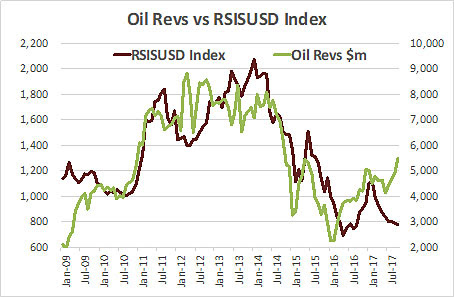
(Source: Iraq Stock Exchange (ISX), Rabee Securities, Iraq’s Ministry of Oil, AFC)
(Data as of October)
However, the market continues to lag and the obvious question is what gives? The answer is simply a function of low liquidity suffering from the continued absence of foreign investors and still constrained local liquidity. The chart (below) shows an index of foreign activity on the ISX, highlighting anaemic foreign activity, indicating lack of inflows, and continued outflows as reported in the last few months, but with both sides meaningfully lower than last year and certainly below earlier years.
Index of foreign buying and selling on the Iraq Stock Exchange (ISX)
And their 10 day-moving averages

(Source: Iraq Stock Exchange (ISX), AFC)
While foreigners are an important source of liquidity, local liquidity is far more important but it too has been almost non-existent which is a function of the significant time lag between recovery in oil revenues and the liquidity filtering down into the real economy, and ultimately into the equity market. The observed time lag is about 7-9 months, which the chart below shows: it shifts the Y-Y percentage change in M2 back by 9 months vs the Y-Y percentage change in oil revenues. While no correlation is perfect nor always true, the chart suggests that the money supply has yet to reflect the significant recovery in oil prices of late 2016 coupled with higher export levels. Arguably, the changed dynamics of the oil market suggest that the recovery in oil prices should have a sustainable positive effect on local liquidity.
Oil Revenues Y-Y percentage change vs M2 Y-Y percentage change
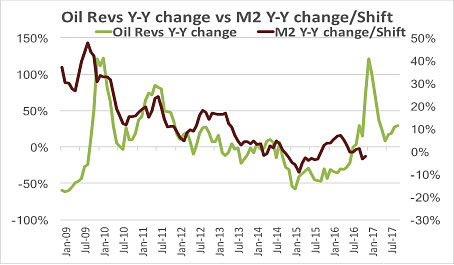
(Source: Iraq’s Ministry of Oil, Central Bank of Iraq, AFC)
(M2 data are as of Jul with est’s by AFC for Aug & Sep, while Oil revenues are as of Oct)
Following the events of Kirkuk, Iraq’s PM visited Saudi Arabia, Kuwait, Jordan, Turkey and Iran, with the most important being Saudi Arabia in which the two countries proceeded to the planning stages for implementing the Saudi led financing for the reconstruction of liberated areas as discussed in August’s newsletter. The immediate steps announced are easily implementable such as developing the recently opened border crossing and increasing investments by Saudi companies in Iraq, with other steps to come down the road.
Unlike the negatives of the liquidity crunch in 2014 which were felt in relatively short order with the equity market down about −68% from peak to bottom, the positives of the revival in liquidity are taking much longer to filter through to the economy, and ultimately to the equity market. All of which underscores the opportunity to acquire attractive assets that have yet to discount a sustainable economic recovery. A sense of the attractive valuations was highlighted in June’s newsletter showing leading bank’s market capitalizations at under 20% of their assets, which themselves are over 70% in cash and cash-equivalents.
As of 31st October 2017, the AFC Iraq Fund was invested in 14 names and held 2.9% in cash. The fund invests in both local and foreign listed companies that have the majority of their business activities in Iraq. The countries with the largest asset allocation were Iraq (97.0%), Norway (2.5%), and the UK (0.5%). The sectors with the largest allocation of assets were financials (53.3%) and consumer staples (23.3%). The estimated trailing median portfolio P/E ratio was 11.34x, the estimated trailing weighted average P/B ratio was 0.89x, and the estimated portfolio dividend yield was 4.46%.
Factsheet AFC Iraq Fund – October 2017
Factsheet AFC Iraq Fund (non-US) – October 2017
AFC Iraq Fund Presentation
AFC Vietnam Fund – Manager Comment October 2017
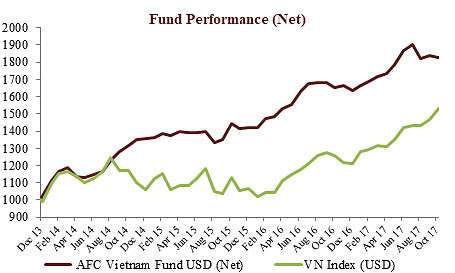
The AFC Vietnam Fund returned −0.7% in October with a NAV of USD 1,827.00, bringing the net return since inception to +82.7%. This represents an annualised return of +16.9% p.a. The September performance of the Ho Chi Minh City VN Index in USD was +4.1% while the Hanoi VH Index gained −2.3% (in USD terms). Since inception, the AFC Vietnam Fund has outperformed the VN and VH Indices by +29.8% and +39.7% respectively (in USD terms). The broad diversification of the fund’s portfolio resulted in a low annualized volatility of 9.18%, a high Sharpe ratio of 1.84, and a low correlation of the fund versus the MSCI World Index USD of 0.28, all based on monthly observations since inception.
During the month of October, we witnessed an acceleration of the selling pressure from previous months out of small and mid-cap stocks. While the index in HCMC increased sharply by +4.1% due to a single stock, mid-caps lost −6.1% on average, while the index in Hanoi was down −2.3% as well. In this sort of environment we were content that our portfolio managed to be relatively stable, finishing the month with a small loss.
Given our growing assets under management and investor base, we decided to increase our fund liquidity and hence reduced the redemption notice period from 60 days to now 30 days. This change will have no impact on our investment strategy, but is certainly beneficial to our existing clients and will most likely attract additional investors.
Market developments
The discrepancy between different Vietnamese indices was the highest we have seen since the inception of our fund. It is very unusual to see indices in the same market move in opposite directions to such an extent in such a short period of time. Index composition always results in some under- or outperformance of certain sectors or of different indices, but recent market action is worth noting. The only net contributor to the gains in the main index was one index heavyweight, FLC Faros Construction (ROS) which doubled (!) last month and now has a market cap of USD 4bn. Foreign ownership is less than 2%, so just some local investors are playing this stock. With a valuation of 200x earnings and 20x book value and sales, we are not talking about a fancy high-tech company – no, we are talking about a plain vanilla construction company! Unfortunately, during most trading sessions in the month of October we have seen many more stocks trading down than up which resulted in an extraordinary weak market breadth – once again.
Market Breadth of VN Index / VN Index vs Midcap Index
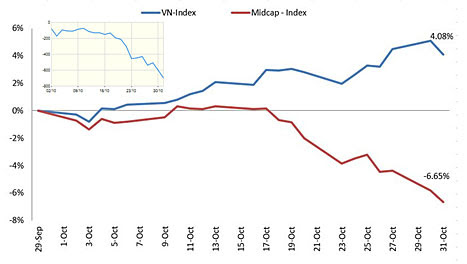
(Source: AFC)
Meanwhile most of our companies have reported their third quarterly earnings and were able to meet our expectations. Hence there was only a minor portfolio rebalancing this quarter, while our valuations continued to get more attractive; just the opposite of what we see for the main index and many other markets around the world.
While Vietnam’s economy has outperformed most other Asian markets for some time now, the recent strength was mainly achieved thanks to a strong acceleration in credit growth, as reported by some banks of around 20%. This trend is of concern to some economists, but bank stocks are in vogue due to increased consumer lending and are now enjoying much higher valuations than most other Asian banks, though this doesn’t seem to bother investors. Foreigners, however, will have to pay a hefty premium in order to buy these banks since the FOL (foreign ownership limit) is already fully used up and only such a hefty premium will tempt some foreign shareholders to sell. As we previously mentioned, given that we are value investors, we wouldn’t buy these index-heavy-weight banks and we will not change our stance on this. But with many new banking stocks now recently listed on the stock market we have bought a bank which on the one hand still has room for foreigners (but whose FOL seems to be closing rapidly) and on the other hand which has a very attractive valuation of 5.6x estimated 2017 earnings despite strong growth in recent years.
With the world on the verge of rising interest rates, investors worldwide are continuing to discuss the possible effects of rising interest rates for stock markets, especially emerging markets which are usually adversely affected in their opinion. A recent JP Morgan study covering the effects of rising interest rates over the past 20 years shows that in reality emerging markets did pretty well, especially stocks offering high dividend yields. With the average dividend yield of companies in our portfolio at approximately 6% currently, we are very pleased to see this confirmation of our strategy in the current interest rate environment. We are not explicitly looking for high dividend stocks, but with our strategy of searching for undervalued companies with strong balance sheets high dividend yields are a very welcomed side effect.
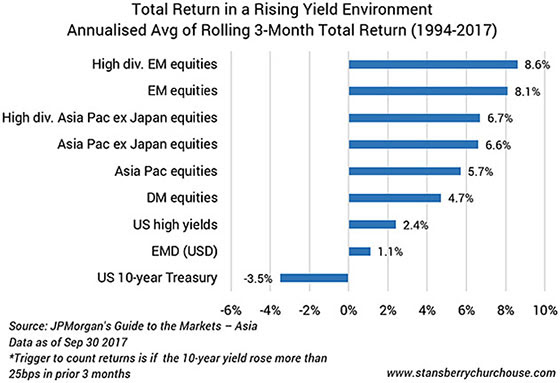
(Source: JP Morgan, Stansberry Churchouse)
Vietnam has a lot of competitive advantages and globalization is a great chance for Vietnam to execute those advantages. Moreover, globalization also helps people to know what they should do to improve themselves and to capture a higher living standard.

(Source: JP Morgan, Stansberry Churchouse)
Vietnam is the fastest growing export-oriented country in the region – In the last ten years Vietnam’s exports grew 16.1% p.a. to become the fastest growing export-oriented country in the region. China is in second place at 8.0%, followed by India (7.9%), Thailand (5.1%), South Korea (4.3%) and Indonesia (3.7%).
Export growth p.a. during 2006-2016 by country (%)

(Source: World Bank, AFC Research)
From 2006-2016, Vietnam’s export revenue grew from USD 39.6 billion in 2006 to USD 176.6 billion in 2016. Exports continued to increase sharply in the first 10 months of 2017, reaching USD 173.7 billion, an increase of 20.7% YoY. Meanwhile, Chinese exports expanded from USD 968 billion in 2006 to USD 2,097 billion in 2016. India’s exports increased from USD 121 billion in 2006 to USD 260 billion in 2016 and Indonesia’s exports gained from USD 100 billion in 2006 to USD 145 billion in 2016.
Vietnam’s exports over the last 10 years (USD billion)

(Source: GSO, AFC research)
The Vietnamese government has facilitated and improved the business environment to lure foreign investors through many favorable policies, such as free land-leases, tax exemptions, etc. This is why FDI disbursements into Vietnam have kept increasing over the past decade and will continue to do so into the future. On the other hand, FDI enterprises create millions of jobs and help Vietnam’s citizens to increase their standard of living. Therefore, Vietnam has one of the fastest growing middle classes in the Asia Pacific region, according to Boston Consulting Group.
Economy
We were very pleased to see that the Vietnamese Government is expecting the public debt/GDP ratio to fall to 62.6% this year, from 63.6% in 2016. Not that long ago, the public debt level was approaching the 65% limit, but the Government has put more effort into managing the State budget and to bring the public debt level back under control and for the time being a trend reversal seems to be in sight, which is very good news.
Industrial product expanded by 8.7% in October, higher than 7.3% in the same period last year.
Exports showed impressive growth in October of 20.7%, reaching USD 173.7 billion. Imports also increased 22% to USD 172.5 billion.
FDI (Foreign Direct Investments) showed another impressive month, with YTD FDI registrations reaching a record high of USD 28.2 billion, +37.4% compared to same period last year, while FDI disbursement increased to USD 14.2 billion, +11.8%.
At the end of October 2017, the fund’s largest positions were: Agriculture Bank Insurance JSC (3.6%) – an insurance company, Sam Cuong Material Electrical and Telecom Corp (2.8%) – a manufacturer of electrical and telecom equipment, Global Electrical Technology Corporation (2.6%) – an electrical equipment company, Cantho Pesticides JSC (2.2%) – a manufacturer of agricultural chemicals, and Sonadezi Long Thanh Shareholding Company (2.0%) – a residential real estate developer.
The portfolio was invested in 77 names and held 2.7% in cash. The sectors with the largest allocation of assets were consumer goods (34.1%) and industrials (28.8%). The fund’s estimated weighted average trailing P/E ratio was 9.93x, the estimated weighted average P/B ratio was 1.76x and the estimated portfolio dividend yield was 7.05%.
Factsheet AFC Vietnam Fund – October 2017
AFC Vietnam Fund Presentation
AFC Travel Report: Pakistan – October 2017
In line with our process of being on the ground in the countries we invest in, Investment Analyst Scott Osheroff travelled to Pakistan in October 2017 to meet with companies on the ground. All photos are by Asia Frontier Capital.
Pakistan is a perfect example of an information disconnect where what is reported in the mainstream media is starkly different from the day-to-day reality on the ground and does not show the full picture. I travelled to Pakistan last month for an investment tour with our local broker, visiting 19 listed companies in Lahore and Karachi, as well as seeing some tourist sites along the way, and was pleasantly surprised by the monumental opportunity Pakistan offers to investors.
My first realization of the current reality in Pakistan occurred when I was boarding my Thai Airways flight from Bangkok to Lahore. The Boeing 777 was fully booked and the only foreigners on the plane, in addition to myself, were about 50 Chinese businessmen. A Chinese presence would be a recurring theme throughout my trip, as the China-Pakistan-Economic-Corrid
Arriving at Allama Iqbal International Airport in Lahore on a Saturday evening at 11pm I proceeded to apply for a visa on arrival. The process was time consuming, taking about 30 minutes despite being the only person in the room, but was easy enough. Upon receipt of my visa and exiting customs I departed for the Pearl Continental Lahore, previously the Intercontinental Hotel. My driver was very friendly and acted as a useful tour guide helping me to get my bearings. Immediately upon leaving the airport, he pointed out two new buildings under construction and identified them as the up and coming Sofitel and Hyatt Regency hotels. With underinvestment in the hotel sector over the past several years there is now a shortage which is leading to renewed investment.
The next morning, I met the other attendees of our investment tour in the hotel lobby and we headed out for a day of Lahori site seeing. We started with a visit to Packages Mall, owned by publicly listed Packages Group. It was reminiscent of the malls in Indonesia or Bangkok in relation to their massive scale. Seemingly every international retailer and F&B chain could be found (including McDonald’s, Burger King, Baskin Robbins, Dunkin’ Donuts, etc.), in addition to several home-grown retail giants such as “Ideas” which is owned by publicly listed Gul Ahmed Textiles and has 40 stores throughout the country.
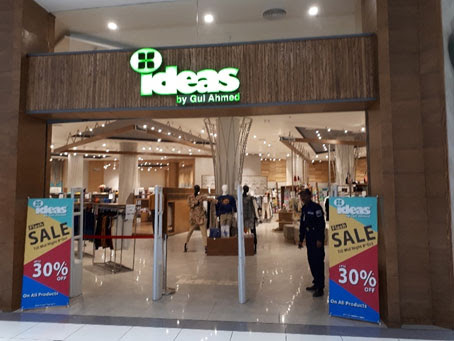
Ideas store in Packages Mall, Lahore.
After departing Packages Mall, we made our way to the historic bazaar-Anarkali, followed by the Shalimar Gardens and a trip to the Wagah Border. Situated 29 kilometres from Lahore, the Wagah Border is the only land crossing between Pakistan and India opened to international travellers. Everyday about an hour before sunset there is a ceremony conducted by the military from each side to officially close the border for the day. A tourist attraction among locals and foreigners alike (of the handful of foreigners in attendance nearly all were Chinese), it was a memorable experience.

Entrance to Anarkali Bazaar
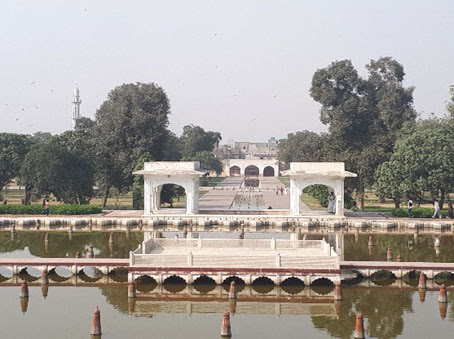
Shalimar Gardens

Wagah Border
That night we had dinner atop a block of stunning historic buildings adjacent to a large Mughal-era mosque. The spread consisted of kebab, lamb chops, several types of delicious breads and my new favourite Pakistani dish – goat brain masala (also called “bheja fry” in the local language across most parts of South Asia).

Food Street adjacent to Mughal-era Mosque

The next day, Monday, we departed early from the hotel for a day of meetings before catching an evening flight to Karachi. We visited a leading insurance company with operations in Pakistan, as well as the UAE, and who foresees the domestic insurance industry growing at a CAGR of 10-15% over the coming years. Being that insurance penetration in Pakistan as a percentage of GDP is only 0.08%, the industry has ample room for growth. Another notable meeting that day was with a top 5 cement producer who is expanding capacity as they project robust domestic demand growth of 8-10% per year over the next three years due to an improving construction market, alongside further investments related to the CPEC. Though domestic cement demand has been quite strong over the past year, higher coal prices as well as pricing pressure has impacted profits in the most recent quarter and worries over these two issues has led to a pretty big correction in cement stock prices. Thus, at current levels there appears to be value in some of the cement names.
Among the other interesting companies whose management we met was the leading private hospital group in Pakistan. They currently have 600 beds and 700 nurses across multiple hospitals, though they have growth plans to see them reach 1,000 beds within 5 years and a potential expansion into Lahore, a city of 7mln, as well as plans to enter Sialkot, a city about 125 km north of Lahore. Recently, this company also announced plans of expanding operations overseas by setting up a hospital in Dar es Salaam, Tanzania. The private healthcare industry in Pakistan is still in its infancy, like with many such industries, meaning that penetration rates can only grow.
I found the issue of low penetration across multiple sectors fascinating, as Pakistan has a population of 190mln, but penetration of refrigerators, air conditioners and washer machines is only 47%, 10% and 57%, respectively. That is not to mention that the country has smartphone penetration of only 25-30%.
That evening we drove to Allama Iqbal International Airport and departed for Karachi, the commercial and financial capital of Pakistan, on the national carrier Pakistan International Airways (PIA). Interestingly, as I was on the boarding platform preparing to enter the plane I peered out the window expecting to see the “PIA” logo on the side of the plane. Instead I saw “VietJet.” VietJet is currently leasing 4 planes to PIA and this flight was staffed with a mix of Pakistani and Vietnamese cabin crew.
The next two days in Karachi were a mix of meetings at our hotel and site visits. We met a variety of companies including banks, leasing groups, garment manufacturers and industrial manufacturers. The broad number of industries represented on the stock market was present in the diversity of companies we met and it was encouraging to see the level of professionalism and transparency expressed by their management teams compared to other countries in the region.
Our last meeting of the trip was with a privately-owned car parts manufacturer supplying mainly window glass to the domestic auto manufacturers. The conversation focused on the current and future potential of the industry, which is clearly robust. Auto manufacturers currently have a 3-6-month backlog for new orders depending on the model (motorcycle manufacturers have the same issue). At present, the ratio of autos per 1,000 people in Pakistan stands at 15. As consumer financing becomes more readily available we would expect this number to accelerate rapidly and become more in line with India with 22 autos and Vietnam with 23 autos, according to 2015 statistics.
Besides the company meetings, one of the major talking points in Pakistan these days is the CPEC. These projects can be one of the longer-term growth drivers for the Pakistani economy as a majority of the >USD 50 billion investments over the next 10-15 years will be in power projects. Pakistan has an acute power shortage, with power cuts ranging from 8-12 hours in the peak season (summer) and this lack of power supply is also cutting 1-2% from GDP growth. With power availability expected to improve over the coming years as new capacity comes online, it is expected that GDP growth rates should also improve.
The other benefit of the CPEC investment is that it has led to a marked improvement in the security environment as it would be important to have a relatively stable security environment for the CPEC to succeed. This improvement in security has also led to a more positive economic sentiment amongst corporates and consumers.
While Pakistan is likely to experience continued near term uncertainty surrounding the political environment and a potential devaluation of their currency to repair their balance of payments, long term, as increased stability and security persist along with investment policies to attract more FDI, Pakistan will remain a highly attractive investment destination. In addition to the long-term potential, we see significant value in the Pakistan Stock Market at the current time, with the KSE100 Index trading at a current PE multiple of 8.1x, a valuation which the market had prior to the 2013 national elections which could be an indication that political and macro risks have been discounted to a large extent.





Sorry, comments are closed for this post.